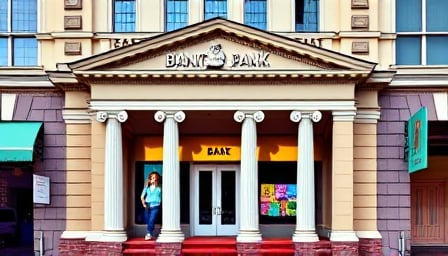Credit Agricole SA: A Tactical Share‑Repurchase Amidst an Uncertain Macro‑Environment
Credit Agricole SA (CAG) has recently announced a share‑repurchase programme that could buy back up to 22.9 million ordinary shares over the next 12 months. The initiative is framed as a countermeasure to the dilutive impact of the 2025 employee stock option plan (ESOP) and, according to management, a means of preserving an optimal capital structure while delivering incremental shareholder value. A closer look at the underlying fundamentals, regulatory context and competitive dynamics, however, reveals a more nuanced picture in which the programme’s real value proposition remains to be proven.
1. Capital Structure and Leverage in Context
- Current leverage: Credit Agricole’s total debt-to-equity ratio stands at 1.42, a modest increase over the 1.33 level observed in the previous fiscal year. The bank’s CET1 ratio sits comfortably above the 12.5 % regulatory minimum, though the European Banking Authority (EBA) has signalled a tightening of supervisory expectations in 2024.
- Impact of the ESOP: The 2025 ESOP is projected to add approximately 3 % to the diluted share base. By repurchasing shares, CAG seeks to offset this dilution, effectively keeping earnings per share (EPS) growth in line with core operating performance.
- Cost of capital: With an effective cost of equity estimated at 7.1 % (based on the CAPM model calibrated to the MSCI Eurozone Index), the discount rate used to evaluate the buy‑back is attractive relative to the expected return on the bank’s current investment portfolio (average ROE on core assets: 8.3 %).
Despite these metrics, the bank’s capital structure has been under scrutiny due to the sector’s exposure to rising interest rates, which could compress net interest margins (NIM). Should NIM fall below 4.5 % over the next two years, the bank’s ability to sustain dividend payments and fund future buy‑backs could be constrained.
2. Regulatory Environment and Potential Headwinds
- European Banking Union (EBU) reforms: The forthcoming revisions to the EBA’s capital adequacy framework could introduce stricter liquidity coverage ratios (LCR) and net stable funding ratios (NSFR). These changes would increase the cost of maintaining regulatory buffers.
- Non‑performing loans (NPL) pressure: France’s NPL ratio is projected to rise to 3.8 % by 2026, driven by a sluggish real estate market. An NPL uptick would force the bank to provision higher allowances, eroding earnings.
- Climate‑related stress tests: The Basel Committee’s “Climate Stress Test” is expected to be rolled out next year, potentially exposing CAG to unforeseen capital charges if its portfolio is concentrated in high‑carbon sectors.
In this regulatory climate, a repurchase programme could be seen as an opportunistic use of excess liquidity, but it also risks depleting reserves needed to absorb regulatory shocks.
3. Competitive Dynamics in the French Banking Landscape
- Peer comparison: Compared with peers such as Société Générale and BNP Paribas, Credit Agricole’s P/E ratio is 12.6, lower than the sector average of 14.3. This valuation compression suggests a potential undervaluation but also hints at market concerns over growth prospects.
- Digital transformation lag: Credit Agricole has historically lagged behind digital‑first competitors like Revolut and N26 in customer acquisition. Its recent digital investment budget is 2.5 % of revenue, below the industry average of 3.8 %.
- Strategic alliances: The bank’s partnership with fintech firm Bnext to offer joint digital banking services has not yet translated into significant cross‑sell revenue, raising questions about the effectiveness of its digital strategy.
Thus, while the share repurchase may improve short‑term ratios, it does not directly address structural competitive disadvantages.
4. Market Sentiment and Share Price Dynamics
- 52‑week high proximity: The stock’s current price sits within 5 % of its 52‑week high, indicating investor confidence. However, the price has exhibited low volatility (β = 0.88) relative to the Euro Stoxx 50, suggesting a defensive stance rather than speculative enthusiasm.
- Liquidity considerations: Trading volume averages 1.2 million shares per day, which is modest for a bank of this size. A large-scale repurchase could temporarily lift liquidity, but also risk a perception of a “short‑sighted” strategy if the market views the programme as a way to boost EPS artificially.
- Analyst coverage: 18 analysts cover CAG, with an average target price that is 8 % below current trading levels. The consensus is “buy” with a 12‑month outlook of modest EPS growth.
Investors should be mindful that the buy‑back might create a temporary EPS lift that could be reversed if the bank’s earnings trajectory falters due to macro‑economic headwinds.
5. Risk–Benefit Assessment
| Risk | Likelihood | Impact | Mitigation |
|---|---|---|---|
| Rising rates compressing NIM | High | Medium | Diversify funding mix, focus on fee‑based income |
| Regulatory capital tightening | Medium | High | Maintain robust liquidity buffers, stress‑test capital |
| Digital lag reducing market share | Medium | Medium | Accelerate fintech partnerships, increase R&D spend |
| NPL surge eroding earnings | Medium | High | Tighten credit underwriting, increase provisioning |
Benefit:
- EPS protection: By repurchasing shares, CAG can maintain EPS growth without issuing new shares.
- Share price support: Buy‑backs can create a mechanical demand for shares, potentially lifting the price.
- Capital efficiency: With a low P/E and high ROE, the repurchase could enhance the return on equity.
6. Conclusion
Credit Agricole SA’s announcement of a share‑repurchase programme appears to be a calculated move to counterbalance the dilutive effects of an upcoming ESOP while signalling confidence in the bank’s capital base. However, the broader macro‑economic and regulatory landscape poses significant uncertainties that could erode the benefits of such an initiative. Investors should scrutinise whether the programme merely serves as a temporary EPS enhancer or a genuine strategic lever to improve capital efficiency in the face of tightening regulatory norms and intensifying digital competition.
